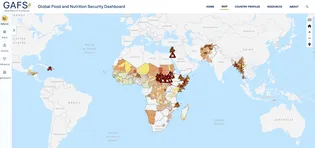Powering rapid responses to food and nutritional insecurity
In 2023 IATI partnered with the Global Alliance for Food Security (GAFS), helping them use IATI data to track, monitor and respond to the global food crisis.
According to the 2024 Global Report on Food Crises, over 282 million people across the world face acute food insecurity. As conflict, economic shocks and the climate emergency continue to drive the global food crisis, timely and accurate data is critical infrastructure that can help deliver efficient and coordinated responses.
Founded in 2022 by the World Bank Group and German G7 Presidency jointly, The Global Alliance for Food Security (GAFS) brings together over 40 institutions to catalyse swift and coordinated responses to food insecurity. One of the core tools under the auspices of GAFS is the Global Food and Nutrition Security Dashboard. The publicly available dashboard provides a worldwide overview of food and nutritional security (FNS) by consolidating data from a wide variety of global, national and sub-national sources. The IATI datastore adds information about over 7,000 activities and 43,000 transactions related to FNS. The dashboard is updated weekly, enabling agencies to access real-time data and act swiftly in response to emerging food crises.
"Our partnership with GAFS has scaled IATI’s impact, providing key data infrastructure driving informed decisions that can save lives in over 25 countries."
GAFS collaborates with other agencies to support countries as they develop and operationalise Food Security Crisis Preparedness Plans. These are national operational plans that define what constitutes a major food and nutrition security crisis, and details step-by-step protocols, roles and timelines for mobilising additional funding. 25 national governments have committed to putting Preparedness Plans in place, with over 60 additional countries expected to develop plans by 2030.
IATI is working with GAFS to provide data infrastructure when a Preparedness Plan is triggered. By annotating IATI data about funding, resources and programme activities related to a specific Preparedness Plan, institutions including the World Bank, USAID and the UN Food and Agriculture Organization can track resources more easily, streamline co-ordination and deliver better outcomes in response to a crisis. Like all IATI data, these tagged activities will be open and freely available to use.
For example, in Somalia, where recurrent droughts severely impact food security, real-time tracking of funding and resource allocation can be critical. When a Preparedness Plan is activated, decision-makers can quickly identify which regions are receiving aid and where there are gaps. If the data shows that a particular district is lagging in resource allocation despite a spike in food insecurity, organisations can redirect funds and supplies immediately.

The GAFS Dashboard offers the latest global and country-level data on food crisis severity, crisis preparedness, global food security financing, emerging risks and potential measures to help strengthen agri-food systems.
IATI data helps to track, monitor and respond to food and nutritional insecurity in three key ways:
- Improving financial oversight by providing up to date, detailed information on funding flows,
- Fostering cross sector collaboration by facilitating alignment between governments, multilaterals and NGOs,
- Enabling agile responses, by ensuring the right resources reach vulnerable populations when and where they are most needed.
As the global food crisis intensifies, the need for real time, actionable data has never been more pressing. Our partnership with GAFS has scaled IATI’s impact, providing key data infrastructure driving informed decisions that can save lives in over 25 countries. This unique collaboration also shows the groundbreaking possibilities for other thematic communities, demonstrating how data can be a powerful tool for addressing global challenges in the link between humanitarian work, development, and peace.